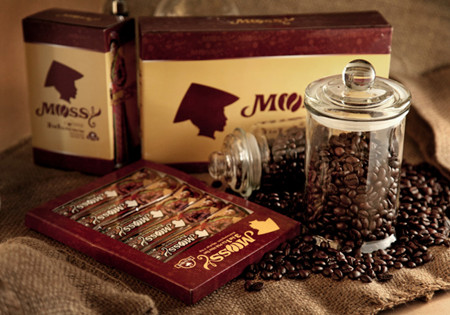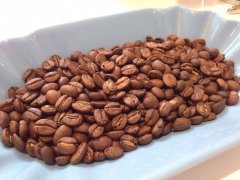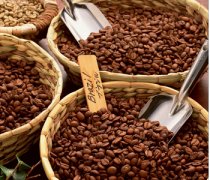Production and processing of Vietnamese Fine Coffee Taste characteristics of Vietnamese Fine Coffee

Brief introduction
Vietnam's geographical location is very favorable for coffee cultivation. Southern Vietnam has a hot and humid tropical climate, which is suitable for growing ROBUSTA coffee, while the north is suitable for growing ARABICA coffee. Each coffee bean used in the current production of Saigon Coffee is selected from the best coffee area in the Vietnamese plateau and is roasted with special cream, with outstanding milky aroma, mellow coffee flavor and unique flavor of Saigon coffee with a long aftertaste.
Traditional Vietnamese coffee is the way of drinking coffee with condensed milk, the flavor is very strong, and the milk flavor basically covers the original aroma, sour taste and charred aftertaste of coffee. And Saigon coffee is slightly different from the traditional Vietnamese coffee, its unique production and processing technology, high standards of ingredients, restore the pure fragrant taste of coffee, so that the majority of consumers drink pure Vietnamese original coffee.
This is the use of a modified Vietnamese pot to extract pure Vietnamese coffee beans by dripping. And the most important feature of Vietnamese coffee beans is baked with special cream, so there will be a strong tropical coffee wrapped with a strong creamy flavor.
There are two main kinds of instant coffee in Vietnam: vinacafe (Weina Coffee) and Central Plains G7 coffee.
Vina three-in-one instant coffee is produced and exported by Vietnam Bian he Vina Co., Ltd., the market share of Vina coffee in Vietnam has been maintained at more than 45%, in a leading position. At present, Wiener has participated in the China-ASEAN Expo for many years, and Wiener Coffee is often seen in some influential exhibitions in the mainland. VINACAFE is selected from the famous high-quality BUONMETHUOT coffee beans, high-quality cream and sugar, full of natural fragrance and value for enjoyment. The product contains 85 calories per 20g, fat 24g (4%), protein less than 1g, carbohydrates 14g (5%), each person's normal daily calorie intake is about 2000 calories, can be adjusted according to personal needs, drinking Vinacafe will never get fat.
Although G7 coffee is also instant coffee, but the taste is rich and mellow, do not taste carefully can not taste instant coffee, similar to the taste of currently brewed coffee. G7 coffee is one of the most famous coffee in Vietnam. Each coffee bean is selected from the best coffee area in the Vietnamese plateau and baked with special cream. G7 Coffee is the only whitecoffee (Milk Coffee) brand on the Vietnamese market, which is refined by advanced European technology. G7 coffee has great advantages in taste and adaptation to the crowd. Customers who have drunk G7 coffee will not feel dizzy, irritable and tasteless, will not affect consumers' sleep, will not affect normal work and study, and bring customers a relaxed and pleasant mood, which is a very remarkable feature different from traditional coffee. The G7 coffee is very suitable for the taste of Asian people, and users who have drunk the product will feel the obvious advantages. In particular, it has the role of regulating endocrine, is a natural beauty fitness daily work fashion coffee.
2 production
Vietnam's geographical location is very favorable for coffee cultivation. Southern Vietnam has a hot and humid tropical climate, which is suitable for growing ROBUSTA coffee, while the north is suitable for growing ARABICA coffee. Coffee production in Vietnam has the following characteristics: (1) because there is no effective way to deal with fallen leaves, medium-grain coffee was selected as the main variety in the early 1980s. (2) based on the planting technology, the coffee planting method was determined, that is, under the hot and humid climate in southern Vietnam, high density planting, large amount of irrigation, excessive fertilization and no shading trees were used to obtain the maximum yield and give full play to the production capacity of medium-grain coffee. The per unit yield of many coffee plantations in Daklak, GiaLai, Kontum and DongNai areas of Vietnam reached 340t / ha. The yield of some plantations is even as high as 89.9 tons per hectare. (3) processing technology: mainly making full use of the solar energy drying method in the dry season in the plateau of central Vietnam to process coffee.
Coffee cultivation in Vietnam covers an area of about 500000 hectares, of which 10% are owned by state-owned enterprises and farms, and 85% by farmers and landowners. The scale of the manor is small, usually 2-5 hectares, and the large manor is about 30-50 hectares, but the number is small. Vietnamese coffee ranks second in all agricultural products exported from Vietnam, second only to rice. Every year, about 300000 farmers are engaged in coffee cultivation, with a labor force of 600000, and the labor force can reach 700000 to 800000 in the three-month harvest period. as a result, the coffee industry has absorbed 1.83% of the country's total labor force and 2.93% of the total agricultural labor force.
Vietnam Coffee Corporation (VINACAFE) is a 100% state-owned enterprise with 73 companies and farms under its jurisdiction. VINACAFE exports 20-25% of Vietnam's coffee production each year.
According to the business statistics of Vietnam Coffee Association, in 2000-2001 (from October 2000 to September 2001), a total of 874676 tons of coffee were exported from 149 units in Vietnam, of which the three largest export companies were OLAM (wholly foreign-owned enterprise, 21326 tons), DAKMAN (joint venture, 18076 tons) and VINAFIMEX (local enterprises, 13719 tons).
The Vietnam Coffee quality Standards Committee was led by the Vietnam Coffee Association to draft the Vietnam National Coffee Standard, which was reported to the Ministry of Science, Technology and Environment (now the Ministry of Science and Technology) for examination and approval. [1]
3 processing
In the field of coffee processing, there have been some dilapidated processing plants since 1975, and there are several processing plants in northern Tongjiao, Fukui and other places, whose equipment was made in East Germany from 1960 to 1962. In the south, the old factories left by former landowners such as ROSSI,DELPHANTE are also small. While expanding the coffee planting area, Yue also began to build new coffee processing plants, first producing some stand-alone equipment, and later imitating the production line according to the HANGXA style, the main manufacturers are the Haiphong May 1 Machinery Factory, the Ministry of Industry A74 Plant in Shoude, Ho Chi Minh City, and so on. In recent years, many companies and farms in Vietnam have imported new processing plants with relatively complete equipment from Germany and Brazil, and imported more than a dozen sets of coffee processing production lines from PINHALENSE of Brazil. Since then, more and more factories began to imitate and improve their own production of Brazilian equipment. In recent years, the processing capacity of Vietnamese coffee has been greatly improved, which can guarantee the export of 150000 to 200000 tons of coffee kernels per year. In addition, there are many enterprises with inadequate equipment, which only rely on a few stand-alone machines for processing, and purchase newly processed coffee from farmers to ensure export standards. The coffee purchased from the private sector is mainly handled by each farmer through the cement yard or soil yard. Farmers in many places use small grinders to grind dried coffee fruits into coffee kernels and sell them to coffee buyers. This kind of processing leads to the instability of product quality. Coffee produced by companies and farms is usually of good quality and beautiful appearance, such as thangloi, phuocan, vietduc, buonho, Deloitte, etc., which are recognized by customers. Generally speaking, the sale of coffee has not been carried out in accordance with national standards for a long time, and the quality provisions in the sale and purchase contract are very simple, which are only determined through consultation between the buyer and the seller, which can not effectively promote the improvement of coffee quality and the level of the processing industry.
In recent years, the above situation has improved. As the supply exceeds demand, the price of coffee continues to fall, causing the buyer to demand higher quality and to increase the requirements to the seller, such as the general request to try the sample, which is used as a basis for settlement and payment. The coffee industry in Vietnam must improve its processing level in time. In addition to customers demanding higher quality standards, the Vietnamese coffee industry also faces problems in the world coffee market:
The Association of Coffee producing countries (ACPC) supports some Chinese and American coffee producing countries on eliminating low-quality coffee from the world coffee market in order to stabilize the balance of supply and demand in the market.
Since January 1, 2003, EU countries have applied OCHRATOXYNA pollution targets and destroyed substandard coffee on a large scale.
The above requirements of Vietnamese coffee need to be greatly improved in the field of processing in order to continue to adapt and develop.
At present, Vietnamese coffee is still mainly dry-processed ROBUSTA, coffee purchased back to use solar energy to dry. If there is continuous overcast and rainy weather during the harvest season, burn coal or firewood to dry. There are also some enterprises that use blenders for wet processing. The ARABICA with small output is processed completely by wet process. SORTEX color sorter is used for classification in many places. [2]
Important Notice :
前街咖啡 FrontStreet Coffee has moved to new addredd:
FrontStreet Coffee Address: 315,Donghua East Road,GuangZhou
Tel:020 38364473
- Prev

Comment on the flavor of Nicaraguan boutique coffee introduction of Nicaraguan boutique coffee Nicaraguan coffee
Nicaraguan coffee Nicaragua coffee flavor characteristics: moderate acidity, fragrant and delicious. Nicaraguan coffee of high quality is in the forefront of coffee beans in the world and enjoys a good reputation. Its particles are moderate in size, mild in taste and very aromatic and mellow. Nicaragua is located in central Central America, bordered by the Pacific Ocean to the west and the Caribbean Sea to the east. The highlands in the north and the coastal plains in the east
- Next

An introduction to the Origin of Fine Coffee-- the characteristics of Fine Coffee in Guatemala
Guatemala's extra hard coffee beans are full-grained, delicious and balanced, and the coffee made with them is pure and full-bodied. Guatemala coffee once enjoyed a reputation as the best quality coffee in the world, but its quality also declined for a time. What is gratifying, however, is that its reputation is gradually being restored. In 1750, Father Jesuit introduced coffee trees to Guatemala, at the end of the 19th century.
Related
- Detailed explanation of Jadeite planting Land in Panamanian Jadeite Manor introduction to the grading system of Jadeite competitive bidding, Red bid, Green bid and Rose Summer
- Story of Coffee planting in Brenka region of Costa Rica Stonehenge Manor anaerobic heavy honey treatment of flavor mouth
- What's on the barrel of Blue Mountain Coffee beans?
- Can American coffee also pull flowers? How to use hot American style to pull out a good-looking pattern?
- Can you make a cold extract with coffee beans? What is the right proportion for cold-extracted coffee formula?
- Indonesian PWN Gold Mandrine Coffee Origin Features Flavor How to Chong? Mandolin coffee is American.
- A brief introduction to the flavor characteristics of Brazilian yellow bourbon coffee beans
- What is the effect of different water quality on the flavor of cold-extracted coffee? What kind of water is best for brewing coffee?
- Why do you think of Rose Summer whenever you mention Panamanian coffee?
- Introduction to the characteristics of authentic blue mountain coffee bean producing areas? What is the CIB Coffee Authority in Jamaica?

